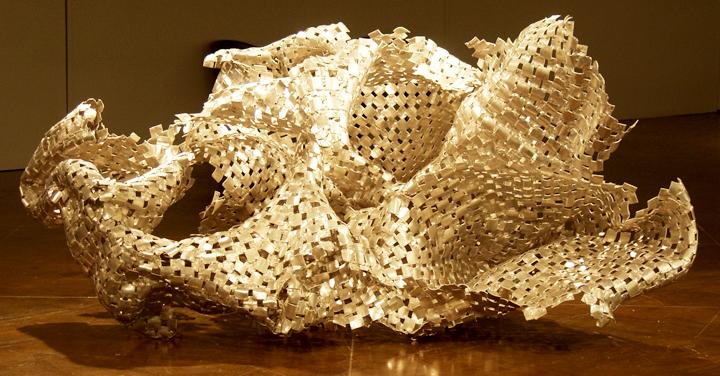A branch crashed through the bathroom ceiling. Terrified, she and the dogs ran into the living room.
“Look out at it,” her roommate said. Every tree in their yard lay flat on the ground like paper blown away by a breeze. They watched the tornado travel up the hill, ripping through streets and homes and lives.
Shirley Hayes Dobbins relived April 27, 2011, and the days that followed over and over until they were etched permanently in her mind and body. She had to find a way to express herself. Her escape, the thing that mended her, that kept the post-traumatic stress from eating her away, is the feeling of muddy, wet clay between her fingers and under her nails.
After the 2011 tornado, artists in the Tuscaloosa area did what they could to help themselves and each other find peace in a world of tragedy. This included creating new art, displaying destroyed art and fixing the tattered remains of art that meant a great deal to those who owned them.
“What I started doing was taking pictures of the debris,” Dobbins said. “There was steel just gracefully wrapped around trees. There was plastic and metal hanging from the trees like it was just fabric. I took all those pictures, and then I drew them with pen and ink and used that as, like, kind of abstract art. I guess I was just amazed at how powerful that storm had been that it could just drape steel around a tree.”
She displayed the pieces in a showcase called “I Am Blown Away.” The showcase included drawings of deep, dark skies hanging forebodingly over
broken houses and drawings of trees bent by winds with street posts wrapped around them.
“I was blown away by the lives lost, by how haunted everything was in our neighborhood,” Dobbins said. “You could hear people still searching at night in the debris, and this was seven days after the tornado. I’ve never heard or felt anything like when that tornado was right on us. I can’t describe the way it sounded.”
The pieces sold quickly. Dobbins said this was because people could relate to the agony the art represented.
“That was very healing, to be able to see beauty in something so destructive,” she said.
Craig Wedderspoon, associate professor of art and sculpture at The University of Alabama, displayed the remains of his metal sculpture, “Fast,” for people to view and relate to.
The sculpture stood taller and wider than a person. It was square shards of metal attached at the tips to form an abstract shape. Wedderspoon said he liked the piece a lot. Now, there isn’t much left of it.
According to Wedderspoon, the tornado picked up the piece from where it was being stored, in Professor of Book Arts Steve Miller’s yard, and threw it, leaving metal shards from the sculpture scattered all across the Southeast.
“Somebody found it and thought it was the piece in Woods Quad,” he said. “They put it there and left a note asking if someone would do something to commemorate what happened.”
Several magazines picked up the story. For months after, Wedderspoon said people from all over the Southeast emailed him with pictures of tiny metal pieces that tore off his sculpture. Some flew as far as South Carolina and Georgia, he said.
“Every one of them asked if I wanted them back, but I said no,” he said.
Wedderspoon said the story was so widely popular because people could relate to the violence of the piece.
“People see a similarity to what they went through, being uprooted and put into another state but still somehow existing,” Wedderspoon said. “It’s a marker in a moment of time.”
Steve Davis, a local metal smith, repaired broken pieces of art, such as sculptures, metal tables and porch railings from the April 2011 tornado and, through those pieces, helped mend lives.
“I was doing repairs from the tornado up until a year ago,” Davis said. “All these things meant a great deal to people. It was an honor, really. They’d put their trust in me to make it whole again.”
Some smaller pieces he fixed for free, but the bigger pieces he charged for. However, Davis said that to fix some things, you just have to move on.
“Things are just things,” he said. “It’s really not that important. It’s people’s lives and their actions, people’s needs and emotions. Art is a great therapy, it’s a way to move on and forward with life. It engages people to move on emotionally, mentally and physically.”
Donna Bolsa was one of the residents of the area who brought pieces to Davis after the tornado.
“After the tornado, he fixed some of my outdoor structures that were totally damaged,” Bolsa said.
Bolsa had a handrail from her front sidewalk to the street that was destroyed. With the insurance money, she was able to afford to have Davis build her a new one.
“It ended up being much more beautiful than it had been originally,” Bolsa said. “He listens to what I want, and then takes the time to dream and plan it.”
Residents of the Tuscaloosa area brought Davis their art in the hopes that mending their broken pieces might help fix some of the brokenness inside of them, Davis said.
“They’d say, ‘this is my favorite thing in the yard, think you can do something with it?’ ” he said. “That’s what I do. I try to make the visible whole again. Everything else people have to find a way to put back together themselves.”









